|
|
O R A C L E O B S E R V A T O R Y Report 20-21 October 2006 |
|
|
The weather forecasts for the planned two nights were good (and reality was even better than the forecasts). So I headed out to Oracle Observatory for a two-night stay. I left home at 0445 PDT on Friday, 20 October, and arrived to a perfect cloud-free sky in Oracle at 1305 MST. The local temperature was a comfortable 73°F with just a very slight breeze.
After I set up the tent and equipment I did some short solar observing at 1625 MST with my PST mounted on a camera tripod. The Sun was already low in the sky but there was one small sunspot and one small prominence visible. At sunset I took this photograph of Oracle Observatory. You can see the PST on the left (on the camera tripod), the LXD75-8"SC, a couple of chairs, my equipment table, and the "astronomer's quarters".
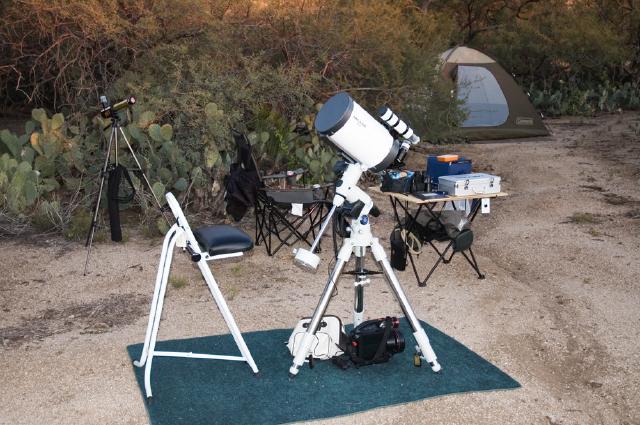
The sky was still clear and turning a deep blue shortly after sunset. The temperature had only dropped to 68°F. Here you can get an impression of what the western sky looked like:
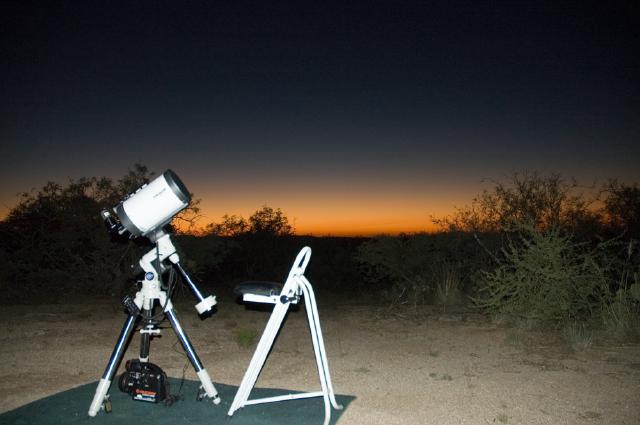
Since I planned to stay two nights, I decided to do some astrophotography of just a couple of objects on this first night and devote the second night to observing. I mounted my Nikon D70 DSLR piggyback on the LXD75-8"SC and used the telescope to manually correct for any guiding errors. The lens focal length was set for 52mm, the ISO at 1600, and Noise Reduction was on. For both objects I took some short test exposures to verify the camera focus and make any needed corrections. As I was using the camera's LCD to verify focus, getting stars precisely focused was a challenge (and I didn't quite make it). Each image below is a "stack" of five 5 minute exposures (and 5 minute NR incamera processing) for an effective exposure duration of 25 minutes for each object using some of the techniques described in the book "A Guide to Astrophotography with Digital SLR Cameras". Photoshop CS2 on Mac OS X was used for the stacking and processing. The first object imaged was the North American Nebula in Deneb in the constellation of Cygnus:
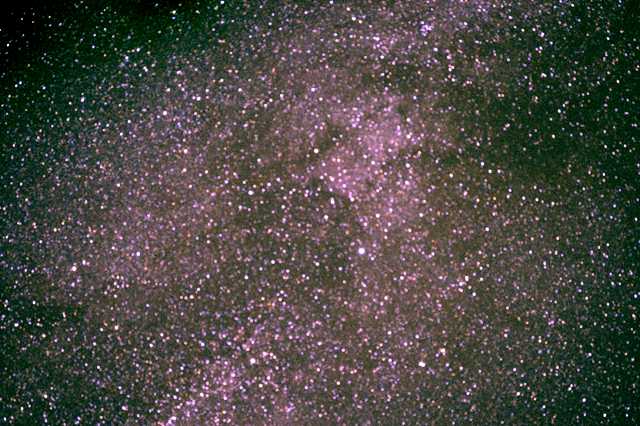
The second object was the Pleiades (M45). The faint bluish nebulosity is easily visible in this processed image:
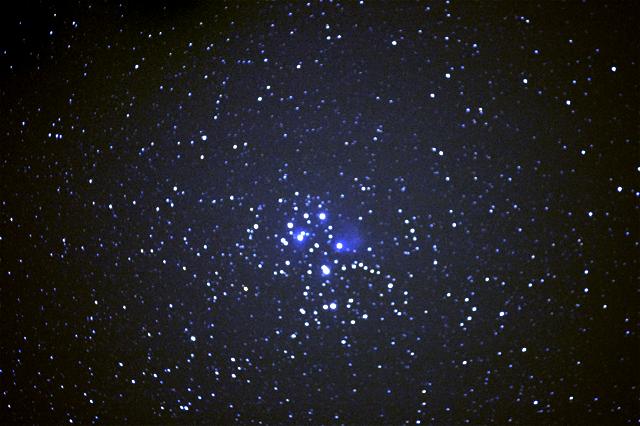
During the night the sky remained clear and with essentially no wind. It was a beautiful night! Unfortunately, I hadn't managed to get much sleep the night before my 8.5 hour drive from California to Arizona so I was getting very tired. I decided to call it a night at 2330. The temperature had lowered to 56°.
Saturday was a repeat of Friday; a perfect cloud-free sky with essentially no wind. I mounted the PST piggyback on the LXD75-8"SC:
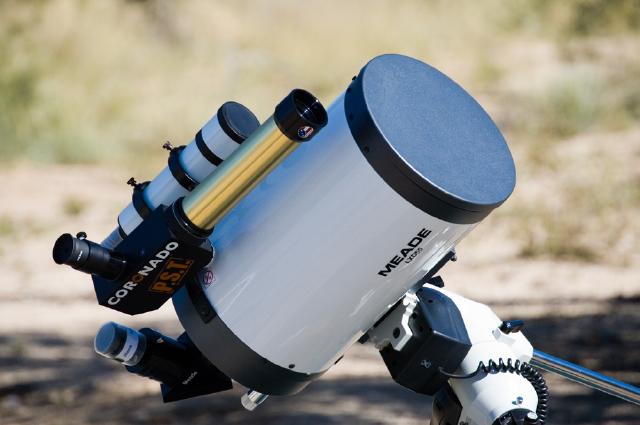
Beginning at 1020 MST I did some solar observing. The Sun was high enough in the sky for more details of its surface to be visible. The sunspot seen the previous afternoon was still visible but there were also now two prominences easily visible on the Sun's limb.
During the day I listened to some audio (old time radio science fiction shows) on my iPod mini, slept some, did some reading (actually rereading of a book I first read back in the 1960s: "Fantasia Mathematica" by Clifton Fadiman - a collection of short science fiction stories with a math theme), and just generally enjoyed the peacefulness of the Oracle Observatory desert location.
At sunset I took these two photographs of some distant mountains with the camera telephoto set to 200mm.
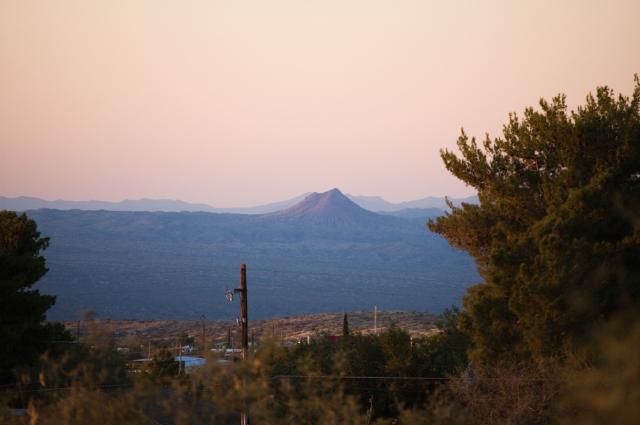
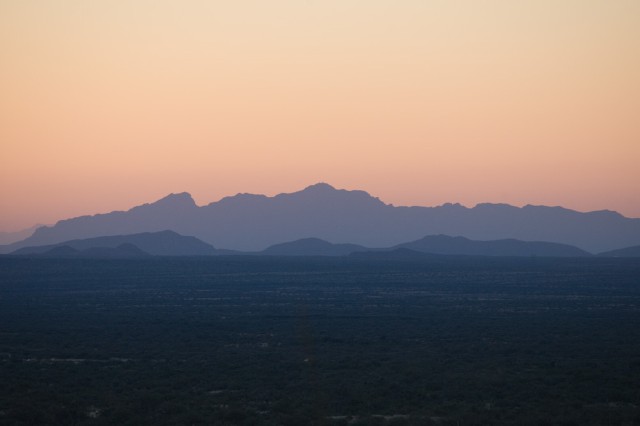
The first one (to the North of Oracle Observatory) was catching the rays of the setting Sun. The second one shows some of the mountain ranges to the west after the Sun had set.
After sunset I started my night's observing with a view of Uranus through the 8". In the 6.4mm eyepiece (312X) it was a small pale blue disk. I decided to let the sky get a little darker before continuing so I relaxed in my recliner and just gazed up at the night sky. The Milky Way was very clear, with nice dark lanes through portions of it. Then at 19h13m40s MST the highlight of the trip appeared as I was just gazing upward. I bright light appeared about 45 degrees above the eastern horizon. At first I thought it was an airplane with its landing light on but as I turned my head to look more directly at it I quickly realized it was a very bright meteor that was moving westward. As I watched, it became even brighter and began shedding off flaming portions. As it passed almost directly overhead it was obvious that this "bolide" was a spectacular one, with a short white tail, a brilliant white head, and the flaming portions falling off. I estimated its magnitude as at least -6 (brighter than Venus when it is at its brightest and with a larger diameter than Venus would ever have to the naked eye). It finally disappeared about 30 degrees above the western horizon. This bolide was probably from the Orionid Meteor Shower, which had its peak the night before (although I saw no meteors at all the night before). This bolide was the best one I've seen in five decades of observing the night sky. (The all time best bolide I've seen was one I saw back in Indiana many years ago during the daytime during a rainstorm! For it to have been visible under such conditions it must have really been a major bolide!!!)
After I recovered from seeing the bolide I went back to the telescope to start observing objects. First up was Neptune, a tiny pale faint green dot at 312X. Then I moved to a couple of globular clusters, M13 and M92, that are conveniently located near (in the sky) to each other. I switched back and forth between them for comparison purposes. Both were nice at 312X but they were best in the 12.4mm eyepiece (161X). M92 appears more compact and smaller in diameter than M13 but it is still a fine object.
I then took the AutoStar's Guided Tour "Tonight's Best" and viewed many globular clusters and nebulae at 161X. The Dumbbell Nebula, M27, was especially nice at 161X. Later I switched to a 40mm eyepiece (50X) to view the Andromeda Galaxy, M31. It was a fine object in the 40mm but the view through my Tele Vue 2" 35mm Panoptic eyepiece (57X) was the best. The field of view of the Panoptic allowed M31 and its companion galaxy, M110, to be seen in the same field of view when M31 was centered. And there was a hint of some dust lanes in M31 in the 2" eyepiece. Nice!!! I then moved to the Pleiades, M45. It was pretty in both the 1.25" 40mm and the 2" 35mm eyepieces. Last viewed was the Double Cluster in Perseus. Another fine object in a wide field eyepiece.
Due to the long drive back home on Sunday I decided to call it a night about 2130 and I packed up all the observing equipment into the car to shorten the time to tear down the site before leaving Sunday morning. The temperature was warmer than the previous night at 60°F. I really hated to turn in as the sky was still perfectly clear and there was no breeze. But there will be more opportunities to observe in future trips to Oracle Observatory.
Return to the top of this page.